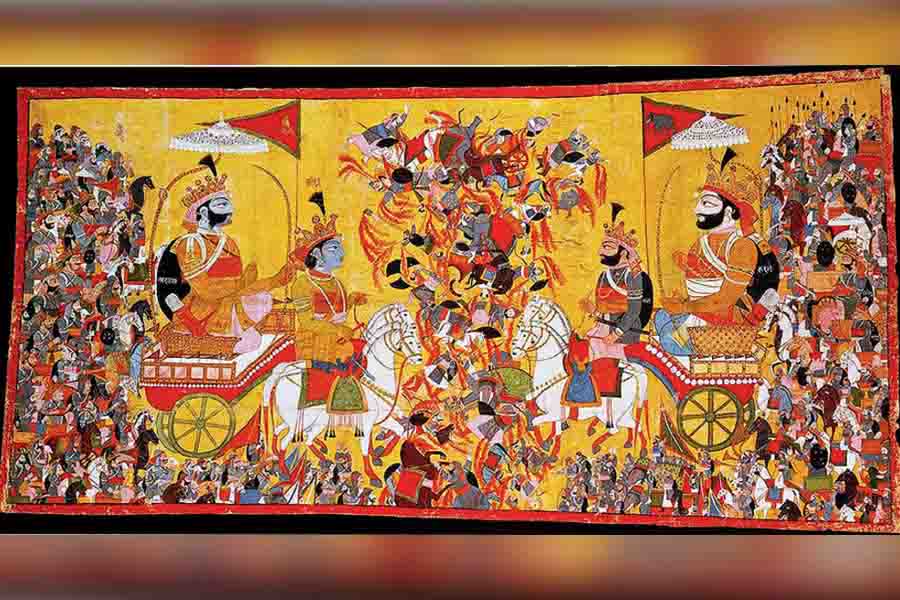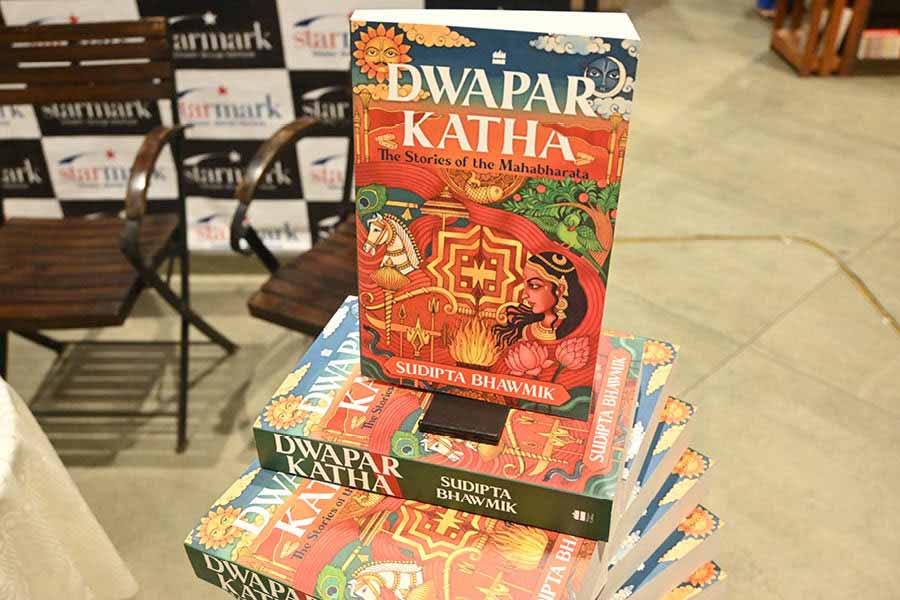Dwapar Katha (published by HarperCollins India) is a successful simplification of the humongous epic that is the Mahabharata. Recounting the world’s longest epic poses the challenge of simplifying without resorting to repeated reductionism. Author Sudipta Bhawmik, who is an Artificial Intelligence (AI) and Machine Learning (ML) expert based out of New Jersey, is also the man behind “The Stories of Mahabharata”, a superhit podcast on which Dwapar Katha is based.
Bhawmik uses the book, whose Kolkata launch took place at Starmark, South City Mall in March, to sum up the key stories from the Mahabharata in 600 pages. With retellings of the Mahabharata becoming increasingly popular, Dwapar Katha allows its readers to acquaint themselves with the original epic itself. In Bhawmik’s words, “The Mahabharata has everything there is, and what isn’t in Mahabharata isn’t anywhere else.”
‘Duryodhan was the most difficult character to portray in an unbiased way’
Bhawmik believes that his concise but faithful adaptation is important for reaching a new audience: “My primary objective was to reach out to the new generations, Gen Z and even younger ones. I think the podcast met this objective to a large extent, and now the book can hopefully do the same thing. The goal is to pass on the story of the Mahabharata to as many young people as possible so that they can do the same in the time to come.”
The biggest challenge in attempting an adaptation of the sort in Dwapar Katha is to maintain objectivity while providing all the important information as present in the original text. This is particularly pertinent when it comes to characterisation, something Bhawmik admits to when he says that “Duryodhan was the most difficult to portray in an unbiased way. Many of the versions of the main text are quite biased [against him], but I tried to highlight Duryodhan’s point of view wherever I could to counteract the bias to some extent.”
The author has divided events into chapters rather than using the kandas of the epic. This means that the reader has an idea of what each chapter entails, while also ensuring continuity. Bhawmik includes tales that encapsulate pivotal plot points, providing adequate representation to both the Pandavas and Kauravas in the process.
‘The sheer diction of Sanskrit helps build the environment of the Mahabharata’

Bhawmik found the chapter on the Bhagavad Gita the toughest to write TT Archives
The anglicisation of original names and key phrases or terms has been done in a way to retain the actual pronunciations as much as possible. To ease matters, Bhawmik retains the English spellings of the more popular names wherever feasible. For example, Pandavas retain the popular spelling, whereas names such as Hidimb and Krishnaa (Draupadi) maintain their original pronunciations. When working on transmuting these terms, Bhawmik explains that “the choice of keeping certain Sanskrit words was with the intention of introducing those terms to the uninitiated reader. In most cases, where I use the Sanskrit word, I explain the meaning, too. The sheer diction of Sanskrit helps build the environment of the Mahabharata.”
Perhaps the most culturally enduring part of the Mahabharata is the Bhagavad Gita, where Krishna’s Mahavishwarup conveys the eternal cosmic truth to Arjuna. Most adaptations summarise the vast text of the Gita into a bite-sized chunk. Bhawmik, too, shortens it to fit his book, but in devoting a whole chapter to it, he lets many of the most important parts of the Gita run through his narrative. “I had to consult other reference texts on the Bhagavad Gita and then condense the essential concepts, as I understood them, into an episode that later became a chapter. In fact, this episode or chapter was the toughest one for me. I wanted to capture the essentials without getting into too much of the philosophical aspects of it. It was a tough balancing act,” explains Bhawmik.
The author also devotes chapters to each day of the Kurukshetra war, lending every major event ample limelight. Throughout the book, the necessities of prophecies and curses are also given due attention, allowing the narrative to jump in time without losing continuity.
The secular nature of the epic is championed and the values of ancient Indian philosophy are upheld

The simple language of ‘Dwapar Katha’ means that even novice readers can grasp it Amit Pramanik
The book contains a number of illustrated line drawings of the most significant events of the story. Onkar Fondekar’s intricate artwork makes the book an immersive experience, crowned with a stunningly detailed cover that befits the rich storyline. Talking about the process of making the cover, Bhawmik says: “We had a lot of discussion regarding the cover, debating different options from minimalist design to complicated ones. We agreed to incorporate visual symbols that represent several aspects of the Mahabharata. So, if you have a detailed look at the cover, you'll find these symbols — Draupadi and her hair, the bow, the fish in the chakra and several others. I preferred a different colour scheme, but the publishers thought this colour scheme would attract more eyes, and I went with their decision.”
Bhawmik’s notes at the beginning and end of the book allow the reader to understand his process of authorship. To anyone who hopes to read about the Mahabharata beyond Dwapar Katha, these two sections prove helpful.
India’s large English readership should ensure that Dwapar Katha reaches a multitude of groups, and its simple language means even novice readers can grasp it. Time and again the secular nature of the epic is championed and the values of ancient Indian philosophy are upheld. Bhawmik’s deft handling of the epic’s themes addresses the issues of casteism, sexism and adharma (breach of duty) without politicising them. At the same time, the ambivalence between good and evil, between right and wrong, which is intrinsic to the Mahabharata, is retained.
For his part, Bhawmik continues to talk about the epic in his podcast, which still has some way to go before it can bring down the curtain on the Mahabharata. Once that happens, it will be interesting to see if Bhawmik can find newer ways to keep telling the story that subsumes so many others.


